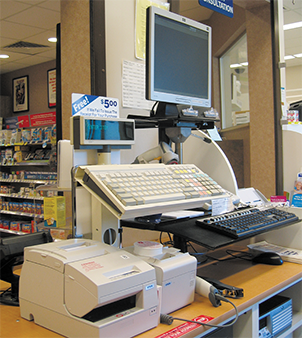9.7 Pharmacy Informatics and Computer System Health
As you have seen, computers, software, and automation play an essential role in the everyday practice of a pharmacy technician. Pharmacies are dependent upon computers and software to process prescriptions swiftly, accurately, and safely; run the cash registers and process credit; track inventory; purchase and receive deliveries; and run measurements to assess productivity and profitability. This is the realm of pharmacy informatics, and it encompasses the use of computer systems and software, online processing, and technology for the integration of pharmacy-related data, information, expertise, and automation.
 Name Exchange
Name Exchange
Pharmacy informatics is also known as pharmaco-informatics.
Technicians who have a love for information technology have a great opportunity to combine their two loves into one by specializing in pharmacy informatics and helping pharmacies tailor their software to their specific needs.
Productivity Reports

The workstation of the pharmacy technician often consists of a computer monitor, cash register, bar code, scanner, credit machine, telephone, and fax machine.
In addition to the many cash register, spreadsheet, inventory, and automation reports that the pharmacy informatics provide, productivity reports can also be generated. These reports compare staff time to prescriptions filled and other income-generating activities. They are formatted in different ways, such as by individual or group staff hours versus prescriptions generated or by individual or group hours versus sales income and reimbursements. Tracking productivity trends can be made visually clear with line and bar graphs.
Productivity reports need to be compared to safety reports. Do safety errors go up as productivity or swiftness of prescription filling goes up? Does customer satisfaction (i.e., waiting time) go up as productivity goes up? Community pharmacies do best when they emphasize safety and customer satisfaction while keeping productivity high. Experienced technicians can help establish and run needed reports, and also design customer satisfaction surveys and safety tracking mechanisms.
Concerns of Security and Stability of Information Systems
Though the move to digital systems makes the data sharing of the cash register, accounting, inventory, and pharmacy records easier and storage more stable, there are some concerns. Most of them revolve around data security. Software programs and online data must be guarded from viruses, data corruption, and hacking. Firewalls from vendors of pharmacy software management systems minimize some of these risks. In recent years, databases of some PBMs and health insurance companies have been compromised by hackers. Technicians need to follow the pharmacy’s procedures for protecting privacy and avoiding viruses.
 Work Wise
Work Wise
Some computer-savvy pharmacy technicians specialize as pharmacy informatic technicians. They help tailor software programs and maintain and repair the systems to fit the needs of the particular pharmacy in which they work.
Copies, or backups, of all data should be made by the main pharmacy computer(s) at regular intervals. A pharmacy can use remote storage, CDs, and other storage devices to back up its prescription records, usually on a daily basis. Some computer systems automatically collect and store prescription data daily with different storage options according to the pharmacy’s database management system (DBMS). For example, Computer-Rx offers two options to its community pharmacy: a nightly backup on an external hard drive that can be taken offsite for safekeeping in an emergency, or a backup system that immediately downloads the data to remote data centers in three different cities. Different pharmacies have different processes, based on their DBMS and their software vendor.
Electronic data storage and shared data information have offered great advantages in times of emergencies—as in fires, tornadoes, and floods—when paper records are often lost.
Computer Maintenance and Emergency Storage
Both the hardware and software of the pharmacy’s computers, programs, and automated technology need to be cared for and maintained to stay high functioning. The equipment manuals for all the equipment must be followed to keep them running well.
Keeping the Pharmacy Software Up to Date
All of the pharmacy computer programs and automated technology must also undergo periodic software updates and upgrades. A software update brings all the information and programming of a currently installed program in line with the highest-functioning version available and the most current resource data. A software upgrade is a new edition of the software product with improved and enhanced capabilities. It is sold by the developer as a separate software product or an upgrade to a current version.
The pharmacy software services or vendors generally have programmed in regular updates and upgrades, or they will notify the pharmacy and technicians that the updates and upgrades are due. Online transmission of new data and programming can then be scheduled during off-hours (such as at night) or a nonpeak period. For regular maintenance and these program changes, the system usually has to be temporarily shut down.
Power and Data Backups for Emergencies
In certain areas of the country, pharmacies may have backup generators for power outages to keep the lights on, computers going, cash registers operating, and refrigerators and freezers running. This is extremely important, as not only the prescription processing and billing depend on electricity, but the drug inventory depends on stable temperatures.
 Practice Tip
Practice Tip
Pharmacies need to take time for data backup and to make contingency plans for natural disasters such as pandemics, tornadoes, floods, and fires.
Many pharmacies in the areas affected by Hurricane Katrina sustained extreme losses due to the power outages and the hot weather that followed. Tracie Hoch, a commercial insurance underwriter, counseled in an emergency planning information brief, “You need a backup generator to not only secure your refrigerated products but also the stock on the shelf. During Hurricane Katrina, the stock on the shelf was condemned by the DEA because it was exposed to such high temperatures and high humidity for a number of days. Those pharmacies were a total loss….” (A change in temperature is not covered in most insurance policies.) Rallying to help, some pharmacies from unaffected areas sent pharmaceutical stock to help meet patient medication needs.
In most cases with a temporary interruption of power during a storm, prescription processing is halted until the power returns, and the pharmacy software system is able to be rebooted. Online insurance processing is also delayed until after internet access resumes. In emergencies, internet and cell phone transmissions can be down, intermittent, or slow, as happened in different areas of New York City right after 9/11. Because of the difficulties of accessing medical records during disasters, many state pharmacy boards allow pharmacists the discretion in an emergency to fill prescriptions based on patient bottles.

Many health records were lost in the flooding from Hurricane Katrina.
 IN THE REAL WORLD
IN THE REAL WORLD
On Monday, August 29, 2005, Hurricane Katrina hit New Orleans, washing away stored patient records in hospitals, clinics, and pharmacies. Many healthcare providers, like their patients, had to flee the city, so patients were left with no medical records or even prescriber memories to guide them.
With the help of public and private organizations, the US government set up KatrinaHealth, a website to help pharmacies, prescribers, and patients access any medical record information available in other data systems or found paper records. Veterans were in the best position because the Veterans Health Administration had been storing records since the 1970s in their VistA electronic health record system. As the entire healthcare system moves to electronic health records and shared data that extends beyond a particular community or region, patient medical records can be reconstructed after an area emergency by drawing on these remote sources.
After Hurricane Katrina, some pharmacies found that the data backups made during the storm were no longer functional, some because of systematic glitches (no backup testing had occurred prior to the storm to see if the systems worked) and some because of computer storage water damage. Technology companies had to try to recover and reconstruct the missing information.
Jon Nolen, VP of information technology at Computer-Rx, told an Elements magazine reporter, “We understand the importance of data backup and what it can mean for a business following a disaster. Our company was devastated by the EF-5 tornado that traveled through the Oklahoma metro area in 1999.” Disaster planning has become more a part of long-range vision in community and hospital pharmacies. (To read the full article in Elements “Preparing Your Business for a Natural Disaster,” go to https://PharmPractice7e.ParadigmEducation.com/PBAHealth.)